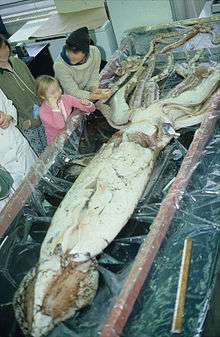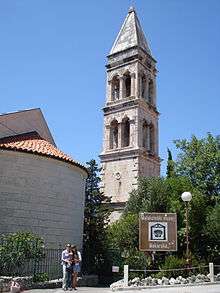Malacology

Malacology[1] is the branch of invertebrate zoology that deals with the study of the Mollusca (mollusks or molluscs), the second-largest phylum of animals in terms of described species[2] after the arthropods. Mollusks include snails and slugs, clams, octopus and squid, and numerous other kinds, many (but by no means all) of which have shells. One division of malacology, conchology, is devoted to the study of mollusk shells. Malacology derives from Greek μαλακός, malakos, "soft"; and -λογία, -logia.
Fields within malacological research include taxonomy, ecology and evolution. Applied malacology studies medical, veterinary, and agricultural applications, for example mollusks as vectors of disease, as in schistosomiasis.
Archaeology employs malacology to understand the evolution of the climate, the biota of the area, and the usage of the site.
In 1681, Filippo Bonanni wrote the first book ever published that was solely about seashells, the shells of marine mollusks.[3] The book was entitled: Ricreatione dell' occhio e dela mente nell oservation' delle Chiociolle, proposta a' curiosi delle opere della natura, &c.[4] In 1868, the German Malacological Society was founded.
Zoological methods are used in malacological research. Malacological field methods and laboratory methods (such as collecting, documenting and archiving, and molecular techniques) were summarized by Sturm et al. (2006).[5]
Malacologists
Those who study malacology are known as malacologists. Those who study primarily or exclusively the shells of mollusks are known as conchologists.
Societies
- American Malacological Society
- Association of Polish Malacologists (Stowarzyszenie Malakologów Polskich)
- Belgian Malacological Society (Société Belge de Malacologie) - French speaking
- Belgian Society for Conchology (Belgische Vereniging voor Conchyliologie) - Dutch speaking
- Conchological Society of Great Britain and Ireland
- Conchologists of America
- Dutch Malacological Society (Nederlandse Malacologische Vereniging)
- Estonian Malacological Society (Eesti Malakoloogia Ühing)
- European Quaternary Malacologists
- Freshwater Mollusk Conservation Society
- German Malacological Society (Deutsche Malakozoologische Gesellschaft)
- Hungarian Malacological Society Magyar Malakológiai Társaság
- Italian Malacological Society (Società Italiana di Malacologia)
- Malacological Society of Australasia
- Malacological Society of London
- Malacological Society of the Philippines, Inc.
- Mexican Malacological Society (Sociedad Mexicana de Malacología y Conquiliología)[6]
- Spanish Malacological Society (Sociedad Española de Malacología)
- Western Society of Malacologists
- Brazilian Malacological Society (Sociedade Brasileira de Malacologia)[7]
Journals
More than 150 journals within the field of malacology are being published from more than 30 countries, producing an overwhelming amount of scientific articles.[8] They include:
- American Journal of Conchology(1865-1872)[9]
- American Malacological Bulletin[10]
- Archiv für Molluskenkunde: International Journal of Malacology[11][12]
- Basteria[13]
- Bulletin of Russian Far East Malacological Society[14]
- Fish & Shellfish Immunology[15]
- Folia conchyliologica[16]
- Folia Malacologica[17][18]
- Heldia[19]
- Johnsonia
- Journal de Conchyliologie - volumes 1850-1922[20] at Biodiversity Heritage Library; volumes 1850-1938[21] at Bibliothèque nationale de France
- Journal of Conchology[22]
- Journal of Medical and Applied Malacology[23]
- Journal of Molluscan Studies
- Malacologia
- Malacologica Bohemoslovaca[24]
- Malacological Review - volume 1 (1968) - today,[25] contents of volume 27 (1996) - volume 40 (2009)[26]
- Soosiana
- Zeitschrift für Malakozoologie (1844-1853)[27] → Malakozoologische Blätter (1854-1878)[28]
- Miscellanea Malacologica
- Mollusca[29]
- Molluscan Research[30] - impact factor: 0.606 (2007)[31]
- Nachrichtsblatt der Deutschen malakozoologischen Gesellschaft
- Occasional Molluscan Papers (since 2008)[32]
- Occasional Papers on Mollusks (1945-1989), 5 volumes[33]
- Ruthenica[34]
- Strombus[35]
- Tentacle - The Newsletter of the Mollusc Specialist Group of the Species Survival Commission of the International Union for Conservation of Nature.[36]
- The Conchologist (1891-1894)[37] -> The Journal of Malacology (1894-1905)[38]
- The Festivus - a peer-reviewed journal which started as a club newsletter in 1970, published by the San Diego Shell Club.[39]
- The Nautilus - since 1886 published by Bailey-Matthews Shell Museum. First two volumes were published under name The Conchologists’ Exchange. Impact factor: 0.500 (2009)[40]
- The Veliger[41] - impact factor: 0.606 (2003)[42]
- 貝類学雑誌 Venus (Japanese Journal of Malacology)[43]
- Vita Marina[44] (discontinued in May 2001)
Museums
Museums that have either exceptional malacological research collections (behind the scenes) and/or exceptional public exhibits of mollusks:
- Academy of Natural Sciences of Philadelphia
- American Museum of Natural History
- Bailey-Matthews Shell Museum
- Cau del Cargol Shell Museum
- Maria Mitchell Association
- Museum of Comparative Zoology at Harvard
- Rinay
- Royal Belgian Institute of Natural Sciences, Brussels: with a collection of more than 9 million shells (mainly from the collection of Philippe Dautzenberg)
- Smithsonian Institution
See also
- Invertebrate paleontology
- History of invertebrate paleozoology
- Treatise on Invertebrate Paleontology
References
- ↑ From French malacologie, contraction of malacozoologie, from New Latin Malacozoa "zoological group including soft-bodied animals" from Greek μαλακός - malakos "soft" + ζῷον "animal.
- ↑ "Home - Division of Invertebrate Zoology".
- ↑ "Buonanni's Chiocciole (1681)". ansp.org. Retrieved 8 August 2009.
- ↑ (Italian) Bonanni F. 1681. Ricreatione dell' occhio e dela mente nell oservation' delle Chiociolle, proposta a' curiosi delle opere della natura, &c. 1681. Varese, Rome, xiv, 384 pp., 109 plates. figure 101.
- ↑ Charles F. Sturm; Timothy A. Pearce; Ángel Valdés (July 2006). The mollusks. Universal-Publishers. ISBN 978-1-58112-930-4.
- ↑ "Sociedad de Malacolología de México A.C.".
- ↑ "Sociedade Brasileira de Malacologia".
- ↑ Bieler & Kabat, Malacological Journals and Newsletters, 1773-1990 ; The Nautilus 105(2):39-61, 1991
- ↑ Tryon, George Washington, 1838-1888. "Details - American journal of conchology. - Biodiversity Heritage Library".
- ↑ "American Malacological Society".
- ↑ "Archiv für Molluskenkunde (ISSN 1869-0963)".
- ↑ "Archiv für Molluskenkunde: International Journal of Malacology".
- ↑ Basteria
- ↑ The Bulletin of the Russian Far East Malacological Society
- ↑ Elsevier. "Fish and Shellfish Immunology".
- ↑ GuppY. "Cernuelle - Folia Conchyliologica" (in French).
- ↑ "Editorial SMP".
- ↑ Folia Malacologica
- ↑ http://www.conchbooks.de/contents/en-us/p342.html
- ↑ "Details - Journal de conchyliologie. - Biodiversity Heritage Library".
- ↑ "Journal de conchyliologie - 77 années disponibles - Gallica".
- ↑ "Journal of Conchology - The Conchological Society of Great Britain and Ireland".
- ↑ "Journal of Medical and Applied Malacology".
- ↑ "Malacologica Bohemoslovaca" (in English and Czech).
- ↑ "Malacological Review".
- ↑ http://runners.ritsumei.ac.jp/cgi-bin/swets/volume-query-e?mode=1&key=&issn=00763004&tr=Malacological+Review
- ↑ Menke, Karl Theodor, 1791-1861. "Details - Zeitschrift für Malakozoologie. - Biodiversity Heritage Library".
- ↑ Clessin, Steph., 1833-. "Details - Malakozoologische Blätter. - Biodiversity Heritage Library".
- ↑ "Mollusca Journal - 2007 to 2009 - The Last Issue - Senckenberg Naturhistorische Sammlungen Dresden".
- ↑ "Molluscan Research - online contents".
- ↑ General Information. accessed 6 December 2010].
- ↑ "Occasional Molluscan Papers". last change 2 December 2014, accessed 23 August 2016.
- ↑ Harvard University. Museum of Comparative Zoology. "Details - Occasional papers on mollusks. - Biodiversity Heritage Library".
- ↑ http://www.ruthenica.com/
- ↑ Strombus online
- ↑ "TENTACLE".
- ↑ http://www.biodiversitylibrary.org/bibliography/16143#/summary
- ↑ http://www.biodiversitylibrary.org/bibliography/16176#/summary
- ↑ Official site of The Festivus
- ↑ "THE NAUTILUS. A Quarterly Devoted to Malacology". shellmuseum.org. Retrieved 6 December 2010.
- ↑ "THE VELIGER". THE VELIGER.
- ↑ "Journal Impact Factor 2003". sciencegateway.org. Retrieved 6 December 2010.
- ↑ "CiNii Articles - 貝類学雑誌Venus : the Japanese journal of malacology" (in Japanese).
- ↑ "404 De pagina is niet gevonden".
Further reading
- Cox L. R. & Peake J. F. (eds.). Proceedings of the First European Malacological Congress. September 17–21, 1962. Text in English with black-and-white photographic reproductions, also maps and diagrams. Published by the Conchological Society of Great Britain and Ireland and the Malacological Society of London in 1965 with no ISBN.
- Heppel D. (1995). "The long dawn of Malacology: a brief history of malacology from prehistory to the year 1800." Archives of Natural History 22(3): 301-319.
External links
![]() Media related to Malacology at Wikimedia Commons
Media related to Malacology at Wikimedia Commons
